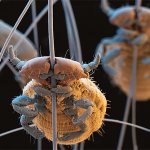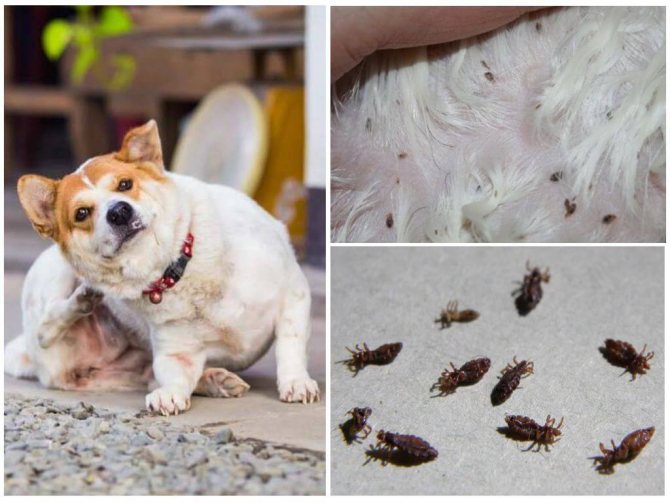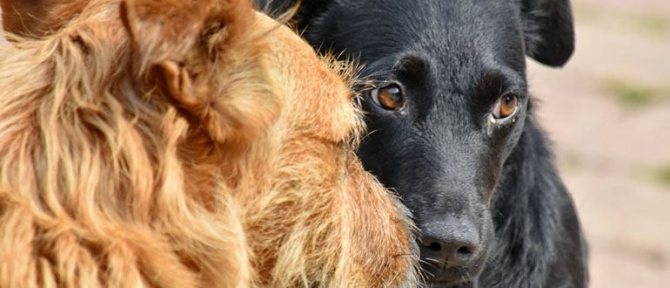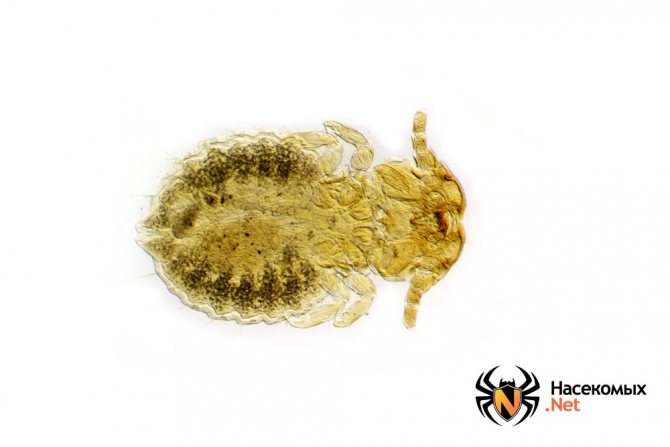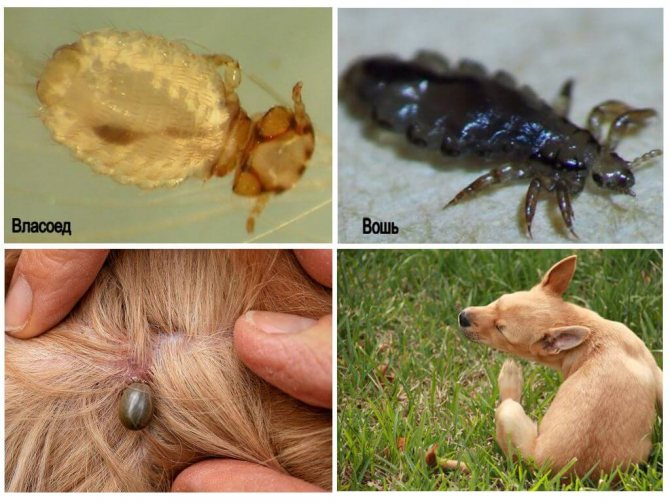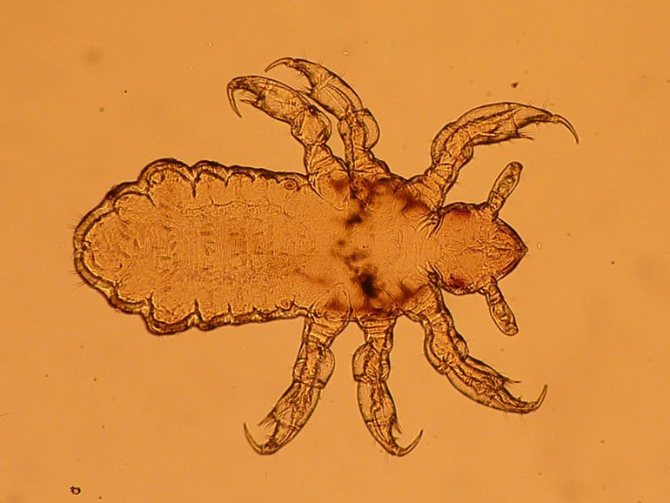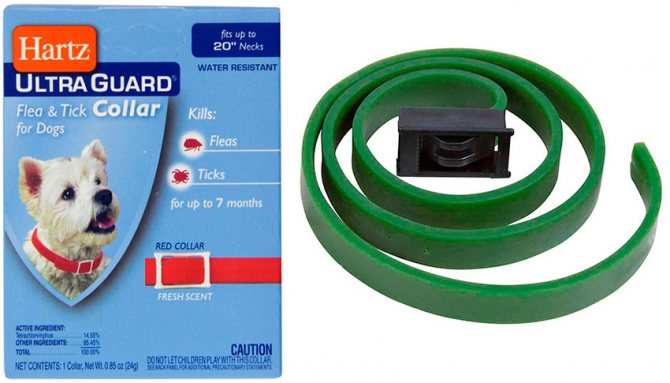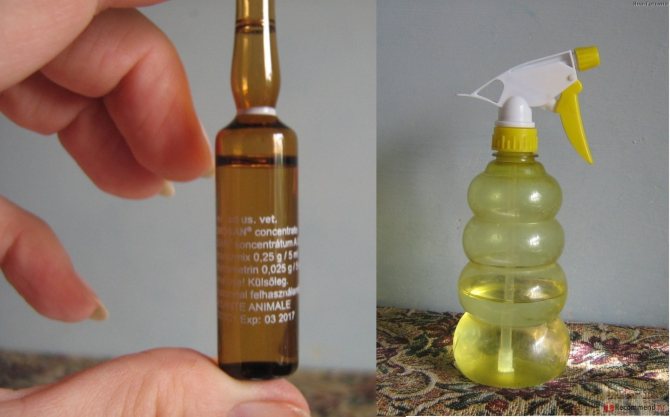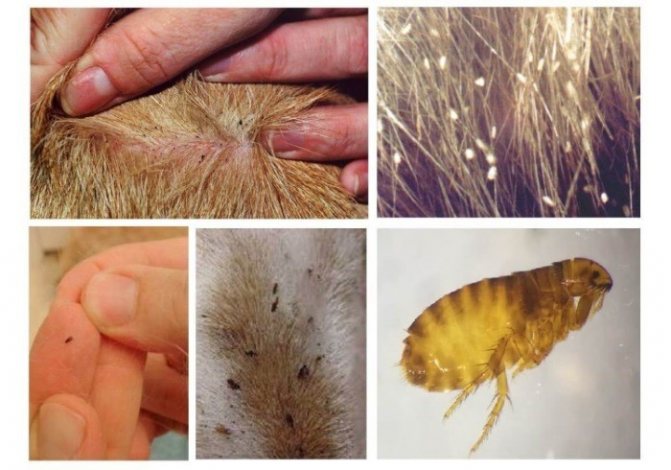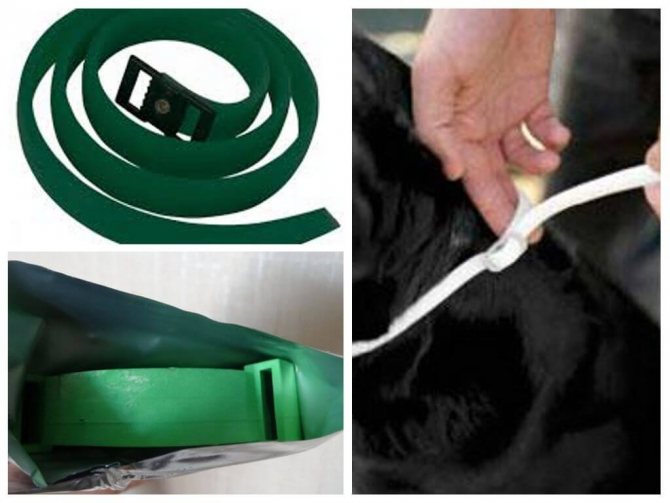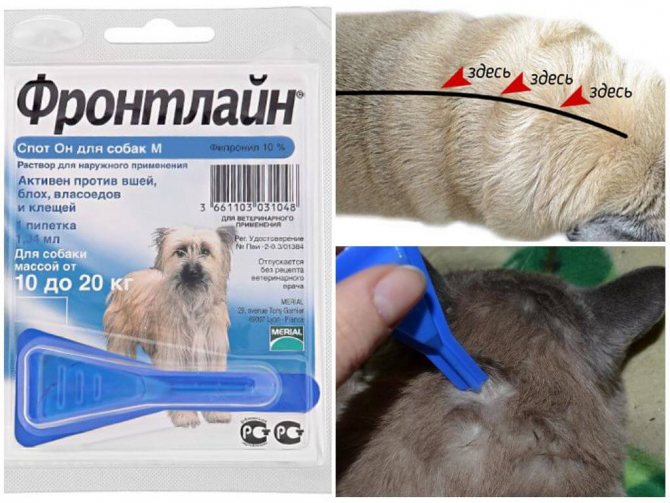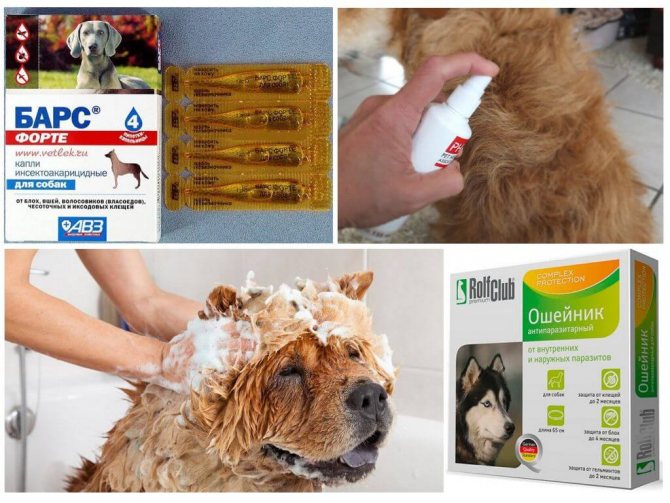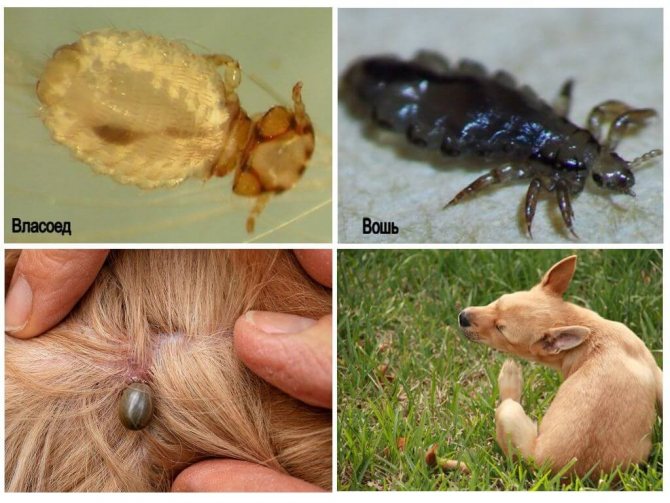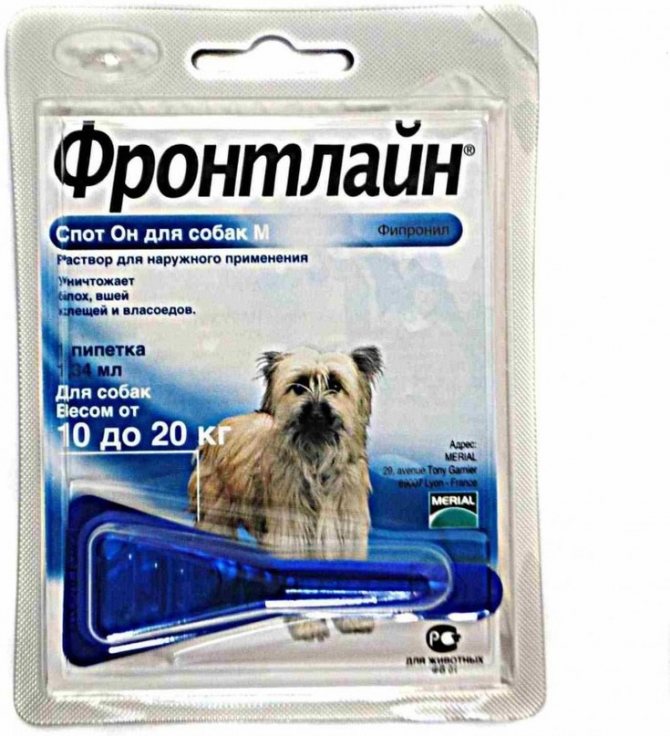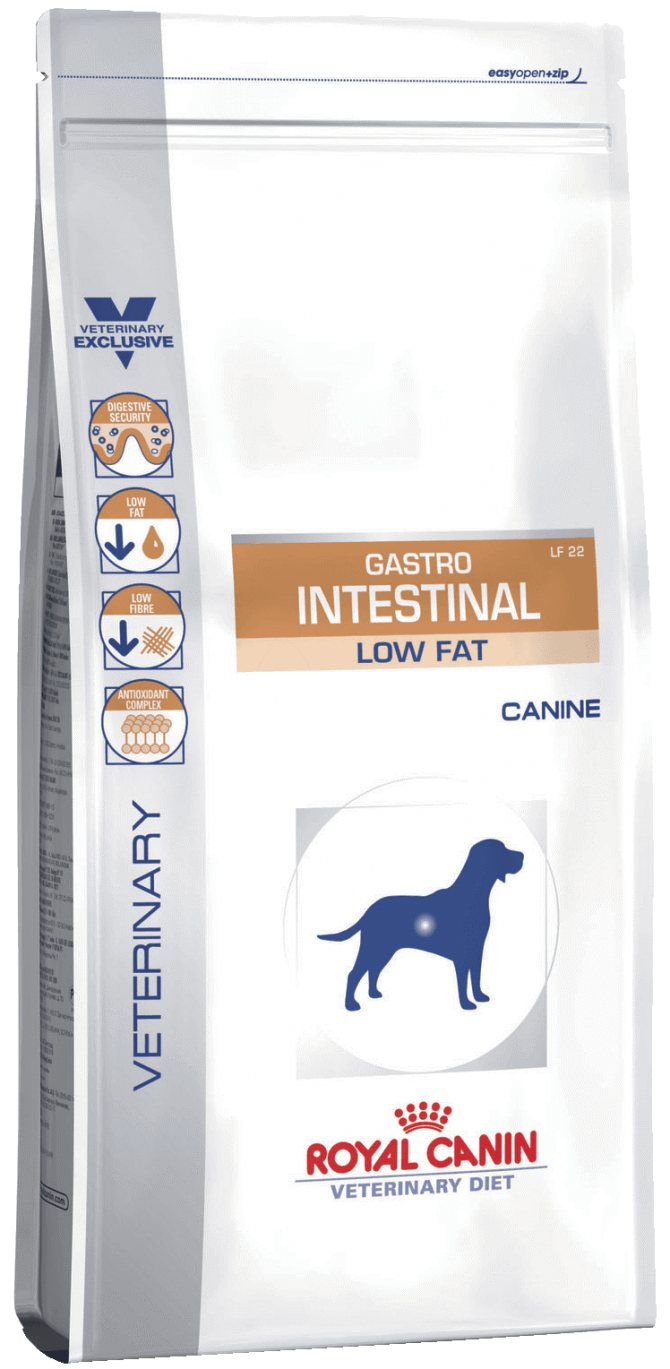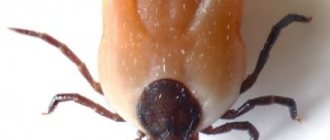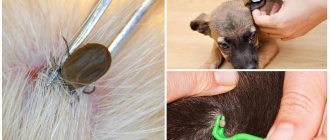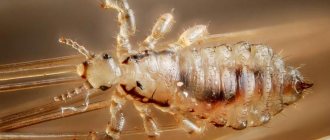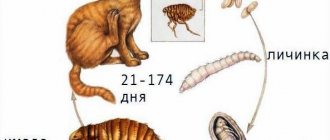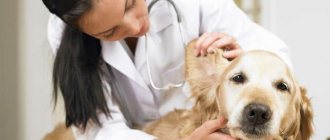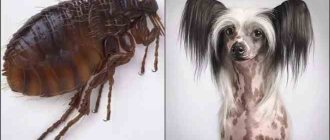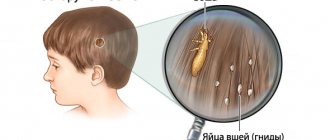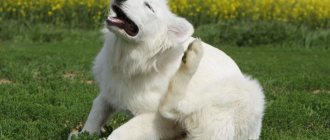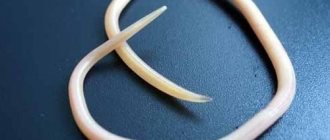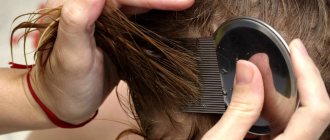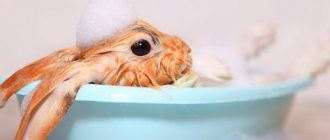To begin with, lice do exist in dogs - this is a scientific fact. Moreover, they torment the four-legged friend no less than the human lice of people. Like humans, lice in dogs are of several different types, differing from each other in biology and body structure:
- the dog louse itself (Linognathus setosus) is a small yellow-gray parasite that causes constant anxiety of the animal, scratching of the skin, and with severe infection, the emaciation of the pet;
- dog louse (Trichodectes canis) - has about the same size as a louse, but when infected, it causes hair loss, dermatitis and constant itching.
The photos below show a dog louse and a louse:
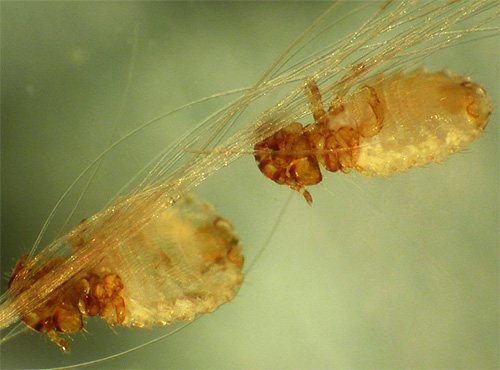
It is very easy to confuse these two parasites, but there will be no trouble in this, since the fight against them is about the same. The main thing here is to be able to detect them on the dog even before serious consequences arise.
In addition to the fact that these parasites cause damage to the coat and dermatitis, lice also carry very dangerous helminths, and they are found in dogs quite often. Therefore, it will be useful for the owner of a dog of any breed to know what lice and lice look like in dogs, as well as how to quickly remove them from a pet.
The photo shows typical signs of dermatitis in a dog:
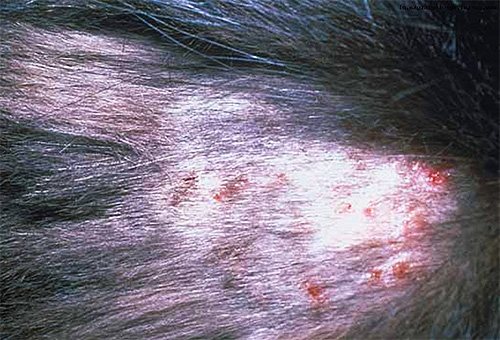

On a note
Lice infestation in a dog is called sifunculatosis.
What do lice look like in dogs
Dog owners need to be familiar with the appearance of the parasite in order to choose the right insect control methods. Dog lice have an oblong, flattened body that is light gray or yellowish in color. The length of the parasite does not exceed 1 mm. The head is small with a developed sucking apparatus. The louse has powerful jaws that can bite through thick skin. A proboscis is located between the jaws, which the parasite inserts into the wound made by the jaws and begins to suck blood.
For a firm grip on the skin on the proboscis there are stiff hook bristles. To quickly move around the body and coat of the animal, there are small, tenacious claws on the limbs. The insect has no eyes. The abdominal region is highly developed, so one individual can suck a lot of blood from a dog.
The louse reproduces by laying eggs (nits) in the animal's fur. An adult secretes a special secret, which hardens under the influence of cold air and firmly attaches eggs to the hair. There is also another type of lice called lice. They feed only on animal hair.
Linognatosis and its symptoms
The entire life cycle of parasites is associated with the dog's body. The female sticks her eggs to the hairs of the animal, and after about half a month, larvae form from them, capable of crawling and sucking blood. A dog can become infected with these insects only by close contact with a sick animal. Puppies get lice from their mother. They suffer more and more from this disease. Infection is also possible through animal care products. For example, such an item could be bedding. Sometimes the owner of the dog brings lice eggs on shoes or clothes, picking them up from the ground, where the sick animal scratched, leaving a certain amount of eggs.
The disease is observed throughout the year, but it occurs most intensely in cold weather. In summer, the number of parasites in animals is significantly reduced.These lice live only on dogs and do not attack other animal species or humans. They are ubiquitous.
The bites of these insects are very painful, and the saliva is endowed with toxic properties. Itching is the main symptom of the disease. When infected with lice, the dog becomes irritable, has a bad sleep, constantly itches, rubs against various objects. The wool grows dull and becomes overgrown with tangles. Scratches, abrasions appear on the skin, baldness sets in. Dermatitis-causing bacteria enter the bloodstream through the scratched skin. Bite sites can become inflamed.
Infection methods
A dog of any breed can become infected with head lice.
The most common routes of infection are:
- Close contact with a sick individual. During a walk, dogs interact closely with each other, and a few minutes are enough for the transfer of insects.
- Through the owner's clothes or shoes. Insects easily crawl from the fur of an infected animal onto human things. For a long time they are able to exist without food, until the opportunity of contact with a potential food source presents itself.
- It often happens that a dog is infected in special salons for pets. For example, during the haircut, the salon specialist used tools that were not disinfected.
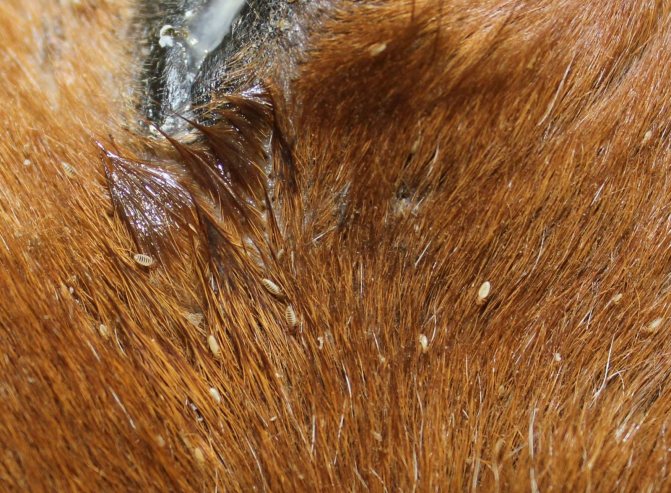

A large number of parasites can live on the body of pets.
The following factors contribute to the faster spread of lice:
- immunity weakened after illness;
- insufficient cosmetic and hygienic care of the pet;
- inappropriate diet;
- chronic diseases;
- old age.
Can dog lice spread to humans?
Lice in dogs
Many are interested in the question of whether lice can pass from a dog to a person. Such insects are not transmitted to humans, despite the fact that the pet is infected. Dog lice parasitize only on dogs and do not pass to warm-blooded other species. Even with close contact of the dog with a person or with a cat, the lice do not run across.
In order to protect your pet from infection:
- it is necessary to protect him from contact with stray representatives of his species;
- the best option would be to purchase a special anti-flea collar for dogs;
- from time to time it is necessary to inspect your pet in order to identify the problem in time and take appropriate measures.
If signs of head lice are found, you should get rid of bloodsuckers immediately.
What are the symptoms
It is not difficult to determine the presence of parasites in an animal, since insects, getting on the skin, immediately begin to feed on the blood of the donor.
The most obvious signs of head lice are:
- Continuous itching caused by parasite bites. The dog is constantly itching, while damaging the integrity of the skin. The result is bleeding combs that attract insects. In the absence of timely treatment, the wounds fester, turning into extensive ulcers.
- The wool loses its luster and strays into dense lumps, which can only be gotten rid of by cutting them out. From the areas that the dog scratches more often, the hair gradually falls out, and bald spots are formed.
- Itching from the bites prevents the dog from fully resting. As a result, there is a depressed mood, loss of appetite.
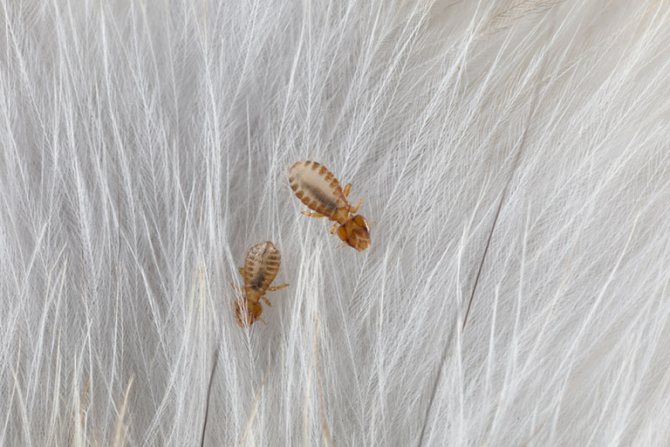

The main clinical symptom of lice in a dog is itching.
Taking into account the symptoms and analysis of the vital activity of lice, it is possible to determine the degree of danger of infection with head lice. First, the nervous and immune systems of the animal are affected. Secondly, loss of appetite leads to gradual exhaustion and weight loss, which contributes to the development of anemia. Thirdly, parasites are the main carriers of the larvae of various types of worms. Fourth, lice are a strong allergen.
Symptoms and signs of lice
Not only a veterinarian can diagnose head lice, lice differ in appearance from other ectoparasites, although they cause similar symptoms:
- Severe itching (due to which the dog scratches the skin to the wounds);
- Deterioration in the quality and appearance of the coat (fading, tangled);
- Baldness at the bite sites is possible;
- Dry dermis, peeling, redness;
- Purulent abrasions, pimples;
- Apathy, insomnia, loss of appetite;
- Exhaustion;
- Anemia with prolonged absence of treatment.
The dog's coat is covered with white dandruff, which does not shake off when brushing. Also, grayish or reddish elongated parasites can be found on the body.
Head lice is not so dangerous as its consequences. Lice multiply rapidly, causing allergic reactions. The dog continues to comb the skin, brings infections to the wounds. The animal is under severe stress, which impairs the immune response and improves the environment for the development of bacteria and fungi. In addition, ectoparasites carry helminth eggs in the glands.
Diagnosis of head lice in dogs
Lice can only be identified with the help of a thorough external examination of the skin and hair of the animal. Especially carefully you should examine the strands that have strayed into tangles. Among a dense ball of wool, it is most convenient for parasites to hide from claws and teeth. For the same reason, another place where lice accumulate is the outer side and base of the auricles.
Having parted the fur and downs, it is easy to notice either an adult or its larva attached to the hair. In the later stages of head lice, foci of dermatitis and seborrhea are clearly visible on the dog's body. Having found head lice, it is necessary to start treatment immediately.
Why are lice dangerous?
Lice infections are rare but not excluded. Lice sucking blood can cause severe anemia, especially in young animals, if the infection is severe. The lice themselves do not do much damage, but scratching, due to acute itching, leads to secondary dermatitis and scratching.
Constant brushing, licking and brushing is an immediate reaction on the part of the dog that can aggravate the symptoms and effects of infection. If the lice are not destroyed in time, the skin of the animal will be full of wounds.
Effective dog lice medications
Veterinarians have been researching the problem of head lice in animals for a long time and are looking for effective solutions to the problem.
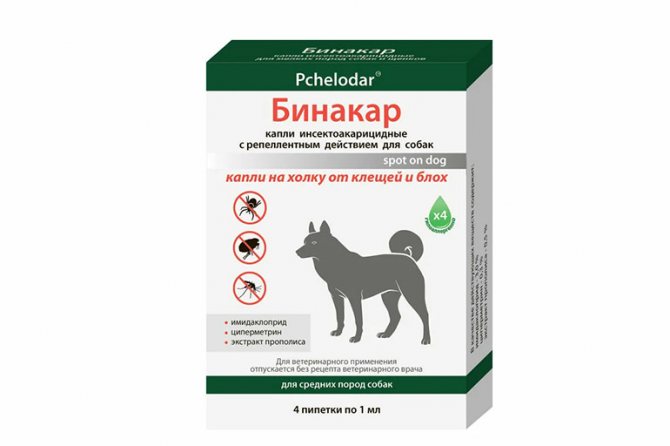

Drops contain insecticidal components.
Every year, the means that help fight skin parasites are being improved. In pharmacies, you can buy medicine in any form of release that is suitable for your dog, taking into account its physiological characteristics. The composition of the universal remedies includes insecticide substances. The motor apparatus of lice is not adapted to jumps, therefore, under the influence of insecticides, all insect individuals die.
Special drops
The drug should be dripped onto the scruff of the dog and rubbed into the skin until completely absorbed. When parasites absorb blood and lymph containing insecticidal substances, paralysis of the nervous system occurs and the insect dies. Some veterinarians advise to distribute drops evenly along the entire length of the spine, which will ensure the rapid spread of the drug with the blood to all parts of the body.
The advantage of this method of dealing with lice is the inaccessibility of the treated area for the pet to lick the medication. Attention should be paid to the reaction of the animal after use. allergic reactions are possible. In such cases, it is necessary to stop using the drug and choose another remedy.
Lice shampoos
How to use: apply shampoo to the animal's fur and grind well so that the liquid is evenly distributed over the entire surface of the body. Leave on for 20-25 minutes, making sure that the dog does not lick the preparation.Rinse thoroughly with warm water. After the wool is dry, use a thick comb to remove dead insects and their eggs. This method is the most comfortable for the pet, because bathing is a familiar procedure for him. For long-haired breeds, one application may not be enough.
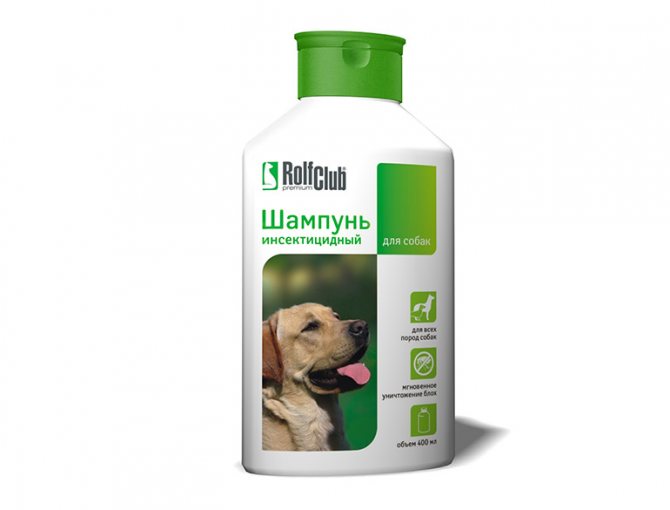

Shampoo is the safest lice remedy for dogs.
Unlike drops, shampoos have a local effect on parasites, so if they come into contact with an infected individual, the dog can get sick again.
Sprays and aerosols
Sprays deal with lice faster than other products. It is required to spray the product over the entire length of the coat, lifting each strand. Pay special attention to the ears and chest. During spraying, make sure that the sprayed medicine does not get into the eyes. It is necessary that the preparation is completely dry. During this time, a special collar or muzzle is put on the animal to prevent licking.
Lice collars
One of the fastest and safest ways to get rid of head lice. Collars are impregnated with special insecticidal compounds and contribute to the death of both adults and their eggs. A week is enough for the complete elimination of parasites.
In addition, the collar is an effective prophylactic agent. Dogs that live outside the house or apartment need protection from fleas and lice in the form of a collar. The disadvantages are possible damage to the skin at the point of contact with the accessory and allergic reactions to the composition of the preparation with which the collar is impregnated.
Prophylaxis
Opposite collars are used to prevent ectoparasites from attacking. They are divided into chemical, biological, and ultrasonic. Most dog handlers use insecticidal accessories. Chemical collars are toxic to small puppies and weakened dogs. Therefore, if ectoparasites are found on the cubs, they are bathed with repellent shampoos that repel insects. The treatment provides short-term protection from attack until the age at which the insecticidal drops are allowed.
Constant grooming is required. The formation of tangles should not be allowed.
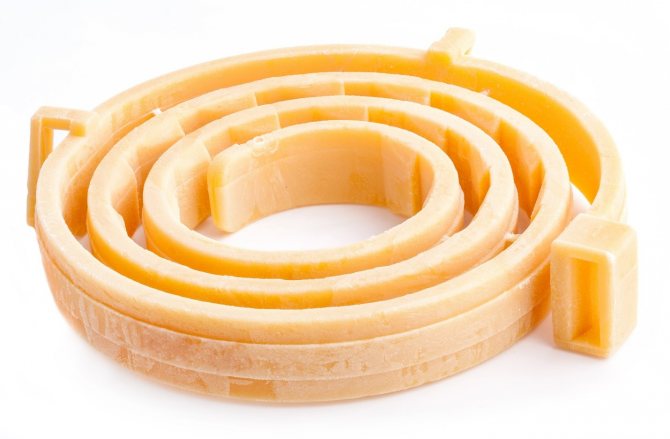

Flea collar
Lice that attack a dog cause it suffering, characterized by constant itching and sleep disturbances. The measures for the destruction of all types of ectoparasites are the same.
We invite you to join our Zen channel and group, where new articles for pet owners are published.
Similar articles:
- Tuberculosis in dogs
- Umbilical hernia in dogs
- Ascites or dropsy in a dog
Rules for the use of funds
In addition to direct processing of the dog's skin and fur, a sanitary examination of the animal's feeding and resting place should be carried out. To do this, the kennel, beds, bedding must be thoroughly washed, treated with a solution of pyrethroid drugs, dried and ironed with an iron. Place hygiene items in water and boil for at least 10 minutes.
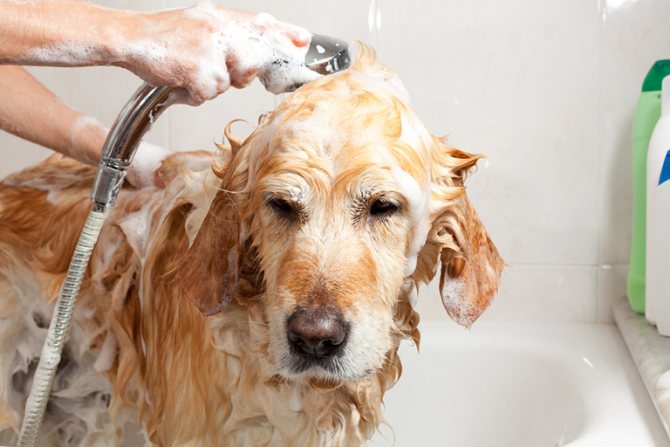

Means are used for treatment and prevention, suitable for small breeds of dogs and puppies.
When applying the drug against lice, be sure to use rubber gloves. Before use, read the instructions, paying special attention to the section "Contraindications". Since all products containing insecticides are flammable, do not smoke during use. It is advisable to wear a protective mask or respirator on your face. If other dogs also live in the house, then the sick individual must be isolated until complete recovery.
Treatment
Animals with head lice should be trimmed and washed with insecticidal dog shampoo. Dog lice are highly susceptible to most antiparasitic drugs. Detergents containing organophosphates, carbonates and other insecticides are suitable for treatment.
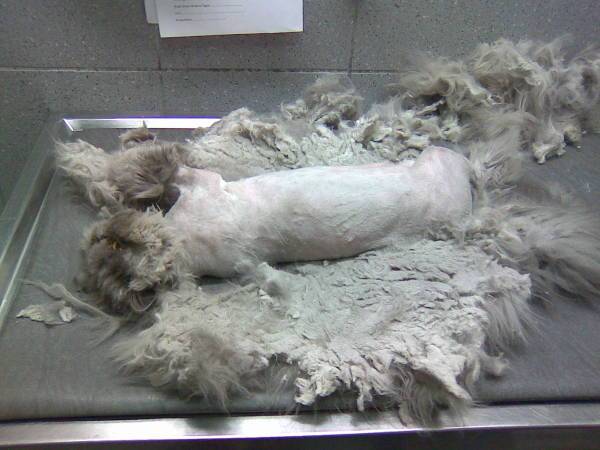

If necessary, the therapy is repeated after 10 days - this period is necessary for the appearance of new sexually mature insects from the eggs that survived after the first treatment.
Dogs that are severely weakened by the parasites require blood transfusions, high-protein nutrition, and treatment of the coat with carbamate-based pesticides. Only after strengthening the general condition of the animal can radical anti-lice therapy be carried out.
Dog lice medications:
| Variety | Features of action and application |
| Drops on the withers | The liquid is poured onto the withers of the animal, spreading the fur. It is important that the drug is in contact with the skin. After a few hours, it will spontaneously spread throughout the body, covering the skin with a thin film. |
| Spray | Sprayed with liquid from a spray can all over the body. After a few hours, the animal is bathed with regular shampoo to wash off the toxic chemical |
| Shampoo | Detergent with insecticides, mainly used for treating puppies or decorative breeds. Inconvenient for treating large dogs |
| Collar | Serves for the prevention of head lice. If lice have already appeared, the collar will not help |
Folk remedies for fleas in dogs
In addition to pharmaceutical preparations, there are many folk remedies for dog lice. At the initial stage of the disease, plants are used that have a pungent odor that repels parasites (for example, tansy, wormwood, mint, lavender or oregano). It is not difficult to prepare a medicinal decoction at home. You should take 50 g of a dry plant, grind and add water. Put on fire and simmer for 10 minutes. Cool and process the dog's coat. Leave for half an hour and rinse with warm water.
Some dog breeders use plants containing essential oils (geranium, tea tree, fir, eucalyptus, clove, lemon, orange, rosemary, etc.). You can use concentrated oil or prepare a solution based on it.


Essential oils ward off parasites.
An effective recipe for a folk remedy made from garlic and yeast. But when using it, it must be borne in mind that some dog breeds react negatively to an overly pungent odor. For the product, you will need several chopped cloves of garlic and half a pack of yeast. Mix the components, sprinkle the resulting powder on the floor surface in the house and all objects that the pet touches. After a day, remove the mixture with a vacuum cleaner.
Treatments with sea salt can also be beneficial. It is recommended to use them in the presence of nits. This is due to the fact that chitin is included in the shell of the louse's egg, which is destroyed by the action of sea salt. Unprotected, the larva quickly dies.
Bathing the animal in sea water is most useful. If this is not possible, you should purchase a pack of sea salt from the store and prepare a bath solution. Place the dog in warm saline and wash thoroughly, taking care not to get water in the eyes and ears. You can also use baking soda instead of salt.
The ingredients for the next remedy are found in every home. Grate a bar of laundry soap, add a liter of water and stir. Put the solution on low heat and boil until sour cream is thick. Instead of water, it is better to use infusions of medicinal fragrant herbs. Remove the mixture from heat, let cool and add 3 chicken yolks. To enhance the effect, you can drop a few drops of essential oil. Use immediately after preparation.
Such aggressive agents as solutions of acetic acid, ammonia, kerosene will also help to remove lice. But they should be used with caution so as not to harm the health of the dog. For pregnant and lactating individuals, puppies, elderly or weakened by chronic diseases of animals, the use of such methods of fighting parasites is prohibited.
Lice types
Itching and multiple skin lesions can be caused by parasites such as lice or fleas. However, in order to get rid of the parasites, the veterinarian must prescribe the correct remedy, so it is important to know the difference between the two.The lice are not as active and move rather slowly. They can be seen with the naked eye. Fleas crawl faster than lice on a dog's skin. There are two types of lice:
- Anoplura(lice) - feed on the host's blood.
- Mallophaga(lice) - feed on dead skin and its derivatives, bite.
Of the order Anoplura in dogs, the most common Linognathus setosus, and from the order Mallophaga there is Trichodectes canisthat parasitizes the host.
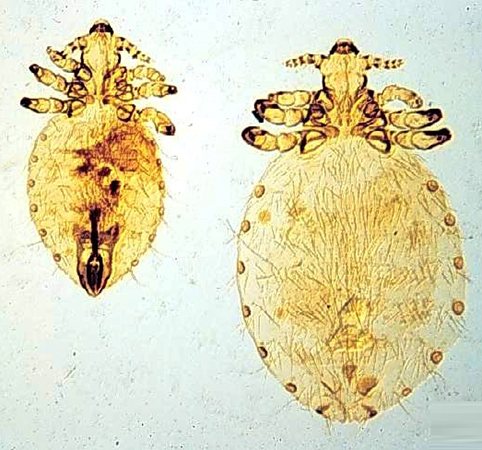

Linognathus setosus
Lice from the squad Mallophaga They feed mainly on the surface layers of the skin, they are more active than lice, which feed on blood, and are much more irritating to the owner, because of which he itches and loses hair, and sometimes becomes aggressive due to irritation. They move fast and are difficult to spot and catch.
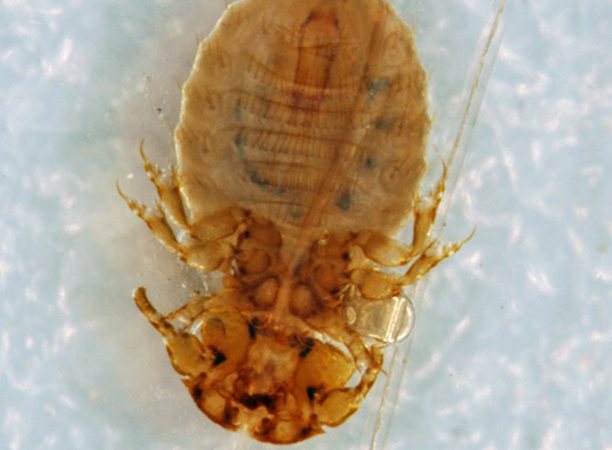

Trichodectes canis
Lice most commonly collect behind the ears and natural openings of the body, most commonly around the anus. Lice mainly appear in winter, when the coat is longest and thickest.
Diseases caused by lice
It is important to remember that diseases caused by lice often develop covertly and are discovered when the body is seriously damaged. In most cases, dogs react violently to discomfort associated with locomotion and lice bites, but there is also an asymptomatic course of infestation.
Note! Lice do not tolerate viral diseases in dogs.
With the classic development of invasion, scratching and wounds are secondarily infected, which leads to inflammatory processes. Because treating inflammation without eliminating the cause is useless.
Vloseods, like fleas, are carriers of borage, an insidious, flatworm that can parasitize for years. Primary infection occurs when the host ectoparasite is ingested. The worm is attached in the intestines and poisons the body with waste products. The eggs of the parasite are released into the external environment with feces, after which, a re-infection of the dog may occur. All pets, including cats, can be infected with the gunman.
It is interesting! Human lice, at one time, often became the cause of typhus epidemics.

